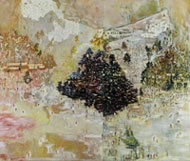I WAS ABLE to view a group of Peter Doig’s paintings recently and felt overawed by them. This was not just because many of them are big, but because they draw the viewer into their patiently worked surfaces. I made notes of the words they invoked: fleshy paint, patched together, disturbing and beguiling, entrancing depths, bleached light, tensions between near and far… the tumble of words continued as I made my way around the paintings. Seldom has my reaction to paintings been so immediately physical and so quick to suggest reactive thoughts and observations.
It is clear from a longer look at the surfaces of his paintings that Doig works on them over a long period of time. They are layered with marks, blobs of impasto and hazy washes of colour. It is as if the surfaces had gathered the patina of time passing despite some evidence of a quickly wielded brush. This sense of concretion deceives the eye and bounces it between those marks that balloon out from the canvas and those that draw us into the expectation of a third dimension. It adds to a premonition that things are not quite as they might have seemed. We are unsettled and disconcerted.
In Ski Jacket small figures pepper the mountainside. They are numerous like the teeming figures in a Lowry painting. They appear to be rather inept skiers in awkward positions strewn across the snow, concentrating on their balance. The sun-lit snowy ground is patched together with free shapes. The dark, wooded central area is forbidding. Doig seems to have carefully considered the underlying abstract forms of the painting alongside a more conventional representation of a ski resort. At some point, deciding the original canvas was not big enough, he added another canvas to it. But again we are left with a sense of disquiet. It is almost as if something were about to happen.
There is something of the visionary here. It is in the promise of light and the dread of darkness. I hesitate to mention William Blake and Samuel Palmer, for neither of them is of direct influence, but they stand as examples of visionary painters who knew that light shines more brightly out of darkness. There is then, an element of the visionary in Doig. There is also an element of the hallucinatory. He has evidently studied the paintings and prints of Edvard Munch – the stance and swirling surrounds of some of his figures attest to that – but he manages to leave us balanced precariously between visions of dark and light. Unlike Munch’s figures Doig’s are not consigned to mental torture, but they do hold a sense of tension.
Many of the paintings Doig has made (until his relatively recent move to Trinidad) have concerned snow, ice and light. They use intense, strange, dominant colours that promise a world that waits to be realised. In them, time is not held as a photographic instant but rather we are left with some sense of what might have been the recent past, of the curious nature of what is present and the question of what the future could bring. So there is mystery here. There is some discomfiture and there is the suggestion of other dimensions.
DOIG IS a self-confessed romantic. He is happy incorporating painterly accidents into his works. He establishes the structure of a painting and seldom changes that structure in a radical way but the tone of the work emerges as the picture evolves. And it is the overall tone which we are left with when we come away from the painting. It seems to me to be a good test of great paintings to consider how much they haunt us. We might remember a pleasing work with a comfortable glow but if we accept that one of the purposes of art is to change the way we see and to challenge us, then the real value is well beyond the merely pleasing. The subjects of Doig’s paintings are part of the structure he lays down, but the way they are worked gives them a depth of feeling that allows them to pervade our memory.
It is usual for Doig to start a new painting from a photograph cut from a newspaper or a brochure. Ski Jacket began like this from a cutting about a Japanese ski resort. But Doig is in no way a slave to his source material. Some paintings have taken him nearly two years to complete. He spends a long time looking. They evolve during these long musings, and he only carries on painting when he has come to know the way forward. None of the paintings is rooted in the place of the original photograph. Themes and subjects are revisited and they seem to express both an autobiographical sense and imaginative addition; a world that infers that it is not as it might first have seemed.
I think it is fairly safe to say that painting, as a medium, has become less fashionable. That being so, it is gratifying to find Doig working in a way that has been impossible for the art establishment to ignore. He is making a body of work that challenges the established conceptual orthodoxy and glitz. In this he is not alone and it leads me to conclude that painting is alive and kicking. It has been good to be stirred from my rather sleepy misconception that the more conventional craftsmanship of painting is rarely being practised, experimented with and pushed into contemporary relevance.
I was not alone in my astonishment and wonder at Doig’s work. The exhibition I saw was extended by many weeks to meet the demand of those who wanted to see what had excited so many viewers and critics. Ultimately Doig feeds our curiosity. He makes paintings that hold drama and romantic vision together with haunting power. They move us so that we never again see the elements of our world in quite the same way. •







